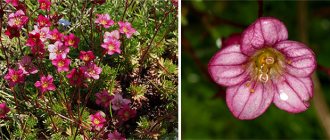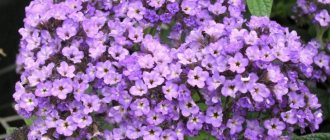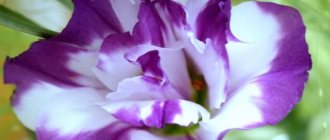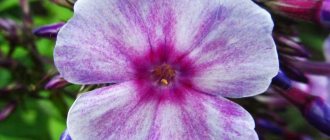Methods of propagation of saxifrage
Saxifraga can be propagated in several ways. Collecting and sowing seeds is only one of them. The material can be prepared independently after flowering.
A combination of saxifrage of different colors is effective - you can buy a mix of seeds or make your own
When planting and caring for perennial saxifrage, it can be propagated by rosettes, that is, by dividing the bush. This method is suitable for adult plants. Carry out the process when flowering is completed. Algorithm:
- Mark healthy bushes. They must have at least three sockets.
- Water the selected plants well.
- Carefully separate the additional sockets from the main one with a knife or a sharp garden spatula.
- Cover the cuttings of the mother plant with soil.
- Bury the separated rosettes in fertile soil. Choose a shaded place.
- Water.
- In spring, plant in open ground.
Comment! When propagated by division, saxifrage is more vulnerable. It takes longer to take root and spends more energy on it.
Before transplanting, rooting rosettes must be protected from the scorching sun. Regular watering and loosening is required.
After flowering, saxifrage can be propagated by cuttings. Algorithm:
- Select long side tendrils.
- Clamp them to the ground with staples.
- Cover the fixatives with soil.
- Water generously.
- Regularly moisten the soil so that the cuttings take root better.
- In the fall, mulch the ground, sprinkle the cuttings with leaves, sawdust or cover them with spruce branches.
- In the spring, separate the rooted shoots and replant them in a permanent place.
You can take cuttings and root them in a box. For the winter, it is better to place them in a cool room in the house. Saxifraga is transplanted in the spring.
Reproduction by cuttings or dividing the bush should be done not only for the sake of obtaining new plants. This also allows you to renew perennials that lose their decorative effect over time. The reason is excessive growth of stems and loss of leaves close to the ground.
Features of growing saxifrage from seeds
When growing saxifrage from seeds, several factors should be taken into account:
- The plant needs good drainage. This is important both when planting in open ground and when growing seedlings.
- The seeds are very small, so before sowing it is better to mix them with five parts of calcined river sand. This measure allows you to avoid excessive thickening of seedlings.
- Every 5-6 years, saxifrage needs to be replanted. This process can be combined well with updating the bushes.
Comment! Not all types of saxifrage can be grown as a cultivated plant. For guaranteed results, it is better to buy varietal seeds.
Saxifraga is popular in landscape design, as it blooms all summer and forms a beautiful continuous covering.
A gentle decoration for your garden: saxifrage - planting and care
Truly, the forces of nature are amazing, and the desire of plants to survive is limitless. A delicate, fragile flower, striving for light, breaks stones. Saxifraga is one of the favorite flowers of landscape designers and gardeners. It grows in a continuous carpet and blooms from May to August.
Saxifraga is an annual or perennial herbaceous plant. There are about 400 species and grows even in the most unfavorable conditions, extracting maximum benefits from them. Natural habitats are Eurasia, Central America and the mountainous regions of tropical Africa.
Saxifraga can be tiny - up to 5 cm in height, and can grow up to 70 cm, covering the soil with a carpet of varying densities. This is a rhizomatous plant, the leaves form a basal rosette and sometimes have a grayish tint, due to their ability to accumulate lime. The leaves grow surrounded by several peduncles, at the tops of which five-petaled flowers of a wide variety of colors are formed, but almost always in very delicate shades. They can be white, pink, purple, yellow. Only some varieties bloom bright red.
Saxifraga can be used to decorate your garden plot, or you can grow it as a houseplant.
Advantages of the plant, types and photographs of flowers
The undoubted advantage of saxifrage is its unpretentiousness and frost resistance. It is pollinated by insects, and some of its species are self-pollinating. This is very useful for creating a colorful floral cover of the soil when several types of ground cover plants are planted nearby, stimulating cross-pollination. Saxifraga pleases not only with delicate flowers, but also with different shapes of leaves, which gives its plantings an even more attractive and interesting look.
Saxifraga is a godsend for inexperienced gardeners; it is easy to care for, and planting it is not difficult at all. But the return can exceed all expectations.
The advantages of indoor saxifrage include its ability to grow in the shade. This is important because house flowers cannot always be provided with proper lighting.
When can you sow saxifrage?
You can sow saxifrage in open ground or with seedlings in spring or autumn. When buying seeds in a store, you should focus on the recommendations for a specific type and variety.
Planting saxifrage in autumn
Saxifraga seeds can be planted in open ground in late autumn. This option is attractive because the material will undergo natural stratification. As a result, seedlings will emerge in spring, and the likelihood of flowering in the first year will increase.
Sowing saxifrage in spring
If you first grow seedlings, it is better to sow in early February. Move plants into open ground until July. In this case, they will have time to gain strength before the fall in order to successfully overwinter.
Planting saxifrage seeds for seedlings
Growing saxifrage from seeds is easy. It is necessary to properly prepare the soil, containers and planting material, and sow it correctly.
Preparing containers and soil
You can buy ready-made soil for seedlings or make a mixture yourself. The following components are taken in a ratio of 1:5:10:20:
- lime (can be replaced with chalk);
- vermiculite;
- sand;
- peat land.
For growing seedlings, you can choose different containers - plastic containers, small boxes, cups. It is important to organize drainage holes, since plants do not like stagnant moisture. The size of containers should be oriented towards a specific variety.
At first, seedlings can be grown in one box or large container, then picking will be required. Individual containers are filled with a mixture of peat and sand.
There is another option - to plant saxifrage seedlings in peat tablets.
Seed preparation
Saxifraga seeds require stratification before sowing for seedlings. After this treatment, seedlings appear faster, plants become stronger and more resilient. Algorithm:
- Place the seeds in a shallow container.
- Apply a thin layer of wet sand.
- Seal the container with a transparent lid.
- Place the container in the refrigerator for three weeks.
For convenience, seed stratification can be done directly in the seedling container. It needs to be filled with soil, and planting material should be spread on top in a thin layer. After stratification is completed, move the container to a bright place at a temperature of 18-20 °C.
How to sow saxifrage
After stratification, the seeds can be sown:
- Fill seedling containers with moist soil mixture.
- Spread the seeds on the surface.
- There is no need to cover the crops with soil.
Cover the container with the planted saxifrage seeds with film, glass or a transparent lid and place it on a light windowsill. The optimal temperature for germination is 18-20 °C.
Seed germination takes 1-3 weeks - the period depends on the variety and quality of the seed
No watering is needed until seedlings emerge. Daily ventilation and removal of condensate are required.
Most popular types
Many varieties of saxifrage decorate gardens and parks. This plant is often used by landscape designers. It has a unique appearance. They are often used to decorate compositions made of stones. But there are also some that can be grown at home. If you have chosen saxifrage from indoor flowers, then pay attention to the following types.
Saxifraga
In its natural environment, this plant can be found in Japan and China. The height of the bush is approximately half a meter. The leaves have stalks and are long. Their shape is similar to an oval, and their size is about six centimeters. One side is a rich green with light veining, while the other is green with an interesting dark red tint.
The flowering period lasts throughout the summer. Sometimes it starts in May. The flowers are not bright and do not attract attention. But their peculiarity is the different size of the petals.
For example, there may be two large ones below, and several small ones on top. They are painted in light and light pink tones with small dark red splashes. This species has a division into varieties. The most famous of them are Harvest Moon with light green leaves and Tricolor with beautiful leaves that have a light pink edge.
Saxifraga cotyledon
In its natural environment, this species is found in the Alps. Flower growers consider it one of the most beautiful species. And with the appearance of flowers, the bush becomes even more beautiful. The plant has a dense rosette, and the leaves are devoid of cuttings. Their shape is oblong, they are about twelve centimeters long and only a few centimeters wide. The edges have a light coating similar to lime.
Flowers appear in early summer. The inflorescences consist of many small flowers, shaped like stars. The size of the inflorescence brush is approximately half a meter. The flowers are light pink in color. But new varieties have already begun to appear that have different shades of flowers.
Saxifraga Arends
This species is considered one of the most numerous. It is distinguished by shiny leaves without cuttings. They are arranged in such a way that they create a socket. This plant grows quickly because of this, its shoots and leaves form a thick coating similar to moss.
Flowers of this species have identical petals in shape and size. But their color can be different, yellowish-green, light, pale pink, lilac and scarlet. It all depends on the plant variety.
In the wild, Saxifraga Arendsa grows in harsh climatic conditions. It is completely undemanding in terms of soil composition and watering.
Saxifraga paniculata
The maximum height of this plant can reach twelve centimeters. The foliage has a bluish tint. The panicle-shaped inflorescences consist of light, pale yellow and scarlet flowers.
Caring for saxifrage seedlings
When growing saxifrage from seeds at home, seedlings need some care. When shoots appear, the shelter must be removed. This is done gradually so that the flower gets used to fresh air. The rest of the events are:
- Water the seedlings with warm water. Focus on the condition of the soil, moisten it moderately.
- At the two-leaf stage, plant seedlings into individual containers.
- Shade plants from direct sunlight.
Comment! Planting saxifrage directly into peat tablets is labor-intensive due to the small size of the seeds. The advantage is that there is no need to pick seedlings.
Medicinal properties of flowers
Flowers grown from seeds
Some gardeners use saxifrage, like the heather flowers described here, for medicinal purposes. The plant has antiseptic and anti-inflammatory properties, and is also used for tumors of the soft parts of the body and as an antifever. The leaves of saxifrage are mainly used.
How to plant saxifrage in the ground
You can plant saxifrage in the ground directly with seeds or seedlings. Each case has its own characteristics.
Deadlines
You can plant strengthened and mature seedlings in the ground in May or early June. The timing is based on the growth rate of the bushes and weather conditions.
Direct sowing of seeds into the ground can be done in April-May. The soil should warm up to 8-9 °C. This option is recommended in the southern regions. In cooler climates, it is better to start seedlings first.
Comment! When directly sowing saxifrage seeds into the ground, the first shoots will appear in 4-5 weeks. If you plant a plant in the spring, it will bloom in May-June or next year.
Site selection and preparation
Saxifraga is quite unpretentious, but still some factors are important for its good development and decorativeness. The site for the plant must meet the following requirements:
- the place is bright, but protected from direct sunlight at midday;
- no moisture stagnation;
- the soil is fertile, moderately moist and light.
Saxifraga can also grow in direct sun. If there is too much light, the leaves can become significantly lighter and there is a risk of burns, which can be expressed as dark spots. Insufficient lighting can slow growth and stop flowering.
Saxifraga feels good in a soil mixture of equal parts of sand, turf and humus. It is effective to add lime, peat, gravel. The selected area must be thoroughly loosened and removed from large roots.
Saxifraga feels good among stones and on sloping areas
Planting saxifrage seeds in open ground
When direct sowing in open ground, stratification is not necessary. Its seeds will pass naturally. The further algorithm of work is as follows:
- Prepare the area.
- Distribute the seeds over the loosened soil.
- Press the material tightly onto the soil or sprinkle it thinly with moistened sand.
After sowing the seeds, the bed can be covered with film. It will prevent moisture from evaporating quickly and will maintain the optimal temperature.
When the sprouts have three true leaves, you need to thin out the plantings, leaving the strongest specimens. Before this, abundant watering is recommended.
Many types of saxifrage grow well, forming a flower carpet - you can leave free space for this in advance
Landing algorithm
Transplanting saxifrage seedlings into open ground is not difficult. The algorithm is like this:
- Prepare the area.
- Water the seedlings generously a few days before transplanting.
- Carefully remove the bushes from the containers, keeping the earthen lump.
- Plant the plants at intervals of 10-20 cm.
Comment! It is necessary to move the seedlings to a permanent place in the evening. Transplantation during the day is possible on a cloudy rainy day.
The best ornamental varieties of saxifrage plants
Indoor saxifrage is perfect for beginning flower growers.
The undemanding nature of most species of this plant allows it to be placed in northern rooms and rooms with moderate access to sunlight. Bright lighting can make the plant look pale and cause disease.
This flower prefers dry and cool environments, it has massive leaves and generously produces tendrils. Saxifraga is a bush, the species of which like sparse watering, soil with plenty of sand, and look good next to petunias.
During the spring-autumn period, acceptable temperature values for saxifrage range from 20 to 25°C. In winter, the plant will suit 12-15°C, its subspecies with variegated leaves will need from 15 to 18°C.
Lighting
The flower can be planted near the shady sides of the window; the best option is the western and eastern sides of the house. Northern sides are also allowed, but when placed on the southern side, it will be necessary to provide the saxifrage with protection from direct rays of the sun.
Direct sunlight is not allowed
Fresh air stimulates its growth, which is why it is often placed on a summer balcony. Intense lighting is harmful, but lack of sunlight can also cause fading. In an open garden, the plant is planted in the shade.
Use settled water at room temperature. The soil should not be oversaturated with moisture, as this will lead to rotting of the roots. Drying out the soil is also unacceptable.
From the beginning of spring to the end of autumn, the house plant is watered no earlier than the top layer of soil has dried to a thickness of 2-3 cm, this is about 2 times a week. When located on open ground, precipitation should be taken into account.
For the winter period, the watering schedule is once every 8-12 days. Water should not accumulate in leaf rosettes; this can also contribute to rotting, and therefore the best method of watering is a tray. It should feed the pot only until the soil is completely moistened.
Spraying
The saxifrage should be sprayed with the same water as for watering. Infrequent spraying is carried out in spring and summer. If the air in the apartment is dry, it is carried out occasionally in winter.
Humidity
In winter, it is not recommended to keep the plant near radiators or heating devices, but to increase air humidity, you can dry wet things on adjacent radiators.
Despite its love for moisture, saxifrage thrives in dry climates, while frequent spraying can be harmful.
Additional Information. Humidity is increased by containing expanded clay, moss or pebbles in the tray; another way to humidify the room is to place vessels with water near the pot.
This flower is adapted to obtain useful substances from scarce mountainous areas and rocks, which is why ordinary soil is not suitable for it. Ideal for saxifrage would be a combination of garden or greenhouse soil, crushed gravel, lime, peat and sand.
All this is enough in the same quantity with the exception of gravel, a handful of which is enough for a volume of 5 liters.
Top dressing
Soil enrichment is carried out in summer, winter and spring with a fertilizer solution diluted in water.
In winter, fertilizing is done once every one and a half to two months, the rest of the time every two weeks.
Note! With a lack of nutrients, the sprouts spread chaotically, and the leaf bases lengthen. An excess increases the risk of fungal diseases.
In winter, the flower remains dormant.
The low activity of saxifrage in winter is explained by its adaptability to weather conditions.
Control of humidity, temperature and fertilizers, the conditions of which are common to most species, should be observed.
Those of them that can grow outside the house and are at the same time in an open garden do not need to be watered and fertilized in winter. Before the onset of cold weather and snowfalls, moderate mulching is necessary; the saxifrage is covered with grass.
These flowers are very diverse in shape, color and size, providing a wide choice for enthusiastic gardeners. For example, the shady saxifrage produces small, soft pink inflorescences, while the opposite-leaved flowers are deep pink and large, becoming purple over time.
Types of flowers
Saxifragas bloom in colors such as:
- white,
- red,
- lilac,
- purple,
- yellow,
- pink.
Additional information: certain varieties gradually change shade. There are also two-color and variegated flowers; the inflorescences of some species are painted with colored spots.
Among the saxifrage flowers, flowers of five short, oblong-rounded petals predominate.
There are also four-petalled ones, but this is a great rarity not inherent in any particular variety. Common standard forms on a smaller scale are bells and complex designs such as the wicker type.
Flowering begins in late spring and early summer; some weather-sensitive varieties may bloom in July.
The formation of inflorescences begins at the end of spring of the second year; they grow in the form of loose panicles. The first time there may be a small number of flowers.
Some varieties bloom in the fall, but generally the flowering time is from three weeks to the end of summer. After it, the flower stalks remain sticking out, so they are usually cut off.
At this time, saxifrage does not need any additional care beyond the usual spring-summer care. For more orderly flowering, panicles are sometimes trimmed.
Cultivated varieties of saxifrage can improve the appearance of any area. Ideal for growing in flower beds, in flowerpots, as well as for organizing organized flower beds and large stones. To grow saxifrage in the garden, choose varieties of soddy saxifrage Arends. The best varieties of Arends saxifrage include:
- Variety “Purpurmontel” - plant height does not exceed 20-25 cm. The flowers are medium bright, purple-pink in color, forming a very dense green carpet. Blooms in early June. The “Purpurmontel” variety is not afraid of frost; when grown as a perennial plant, it does not require shelter.
- Variety “Snow Carpet” - plant height does not exceed 15 cm. The flowers are medium bright, white, forming a dense green carpet. Blooms in mid-May. The “Snow Carpet” variety forms a dense cushion up to 3-5 cm in height. Ideal for decorating rocky areas.
- Variety "Flora Carpet" - plant height no more than 20 cm. The flowers are medium-sized, white-pink. Blooms beautifully on alpine hills. Blooms in early June. The "Flora Carpet" variety forms a dense cushion up to 3-5 cm in height. The only variety that prefers to grow on the sunny side of the site
- Variety “Flamingo” - plant height no more than 20 cm. The flowers are medium-sized, white-pink. Planted in small groups in garden plots and flower beds. Blooms in early June.
The Flamingo variety is most often grown as a perennial plant. Winter-hardy variety.
This rhizomatous plant, which can grow up to 70 cm high, is characterized by:
- creeping stems;
- branched root system;
- pronounced basal rosette;
- fleshy and leathery leaves.
Saxifraga Arends at home
The described plant has several subspecies, which differ mainly only in the color palette. All can boast of resistance to cold and ease of care. Among the most popular varieties are:
- Flamingo. According to the name, it has a soft pink bud color;
- White Carpet. Small inflorescences with snow-white bells bloom above the dark green shoots. Maximum diameter - 1 cm;
- saxifrage Purple carpet (Pink carpet, Purple Carpet). Probably the most beautiful and noble of those listed. Saxifraga purpurea has an aristocratic burgundy color with a yellow core;
- Floral Carpet is a very popular and beautiful plant, which is distinguished by its delicate white and pink shades.
Purple Carpet
Saxifraga Flower carpet covers the ground with graceful petals. Therefore, it is not surprising that all subspecies are very often used for exterior design, especially landscapes.
For your information! On the Internet you can find another name - Anders' saxifrage, but this is a mistake. In the botanical encyclopedia, the plant appears as Arends' saxifrage and has no other names.
Despite its praised unpretentiousness and simplicity, saxifrage still requires some attention for abundant flowering. Several recommendations on how to care for the vaunted plant.
We invite you to familiarize yourself with the Description and characteristics of the tomato variety Money Tree
Arends' saxifrage feels great both under aggressive sun and in partial shade. However, we must remember that keeping a plant in the shade for a long time can have a detrimental effect on its condition.
Important! It all depends on the air temperature. If it is above 20°C, it is advisable to provide the plant with a more shady place. Heat causes the rapid development of parasites and diseases, which has a very negative effect on the appearance of the plant.
Soil and fertilizers
Arendsa prefers light soils:
- loose build;
- low connectivity;
- easy workability.
Saxifraga in macro photography
One of the main factors when choosing soil is the presence of limestone, which has a very beneficial effect on the condition of the plant, fertility and good drainage.
Important! Superphosphate and bone meal are excellent fertilizers for saxifrage.
Although soil fertility is one of the main factors, you should not get carried away with fertilizers. The abundance of nutrients has an impact and is detrimental. Everything is good in moderation.
Watering and humidity
Saxifraga loves water very much. Watering should be done in moderation, since stagnant moisture destroys the roots of the plant. When planting, it is worth organizing in advance the drainage of excess water from the root system, ensuring drainage.
Regarding the temperature regime, saxifrage also has its own requirements. This noble plant does not survive at temperatures above 20°C. Surviving the winter is not a problem, but the heat can provoke many serious illnesses and the proliferation of pests.
Features of care
After moving seedlings into the ground or planting saxifrage with seeds, care should be comprehensive. In general, the plant is unpretentious.
Watering and fertilizing schedule
Saxifraga needs to be watered regularly, but in moderation. Moisturizing is required when the top layer of soil dries out. Watering should be done early in the morning or after sunset. The water should be warm and settled.
On cool days, plants need to be moistened less. In hot weather, the frequency of watering is increased.
Watering saxifrage during the day can cause burns to leaves and flowers.
It is recommended to feed saxifrage every month. The plant does not need fertilizers only in October-February. They should be applied for the first time three weeks after planting.
The flower responds well to mineral compositions. Dosages per 1 m²:
- 15-20 g potassium
- 30-40 g phosphorus;
- 30-40 g of ammonium sulfate, no need to add in summer;
- 25-30 g of ammonium nitrate, use only in spring and autumn.
If you use liquid concentrates, then you need to dilute them twice as much as according to the instructions. Fertilizing should be combined with watering.
Comment! Nitrogen fertilizers provide an abundance of green mass, but have a bad effect on flowering. If there is an excess of fertilizing, there is a risk of death of the root system and the spread of rot.
Loosening, mulching
The area with saxifrage needs to be weeded regularly. Loosening is recommended after each watering or heavy rainfall. The need for this procedure and moistening can be reduced by mulching. It is good to use straw for this. The material must be spread out in a 5-centimeter layer and updated regularly.
Care during the flowering period
During flowering, it is important not to forget about standard care measures - watering, weeding, loosening. To maintain decorativeness, you should regularly get rid of dried leaves and flower stalks.
Advice! To maintain the decorative appearance of saxifrage after flowering, it is recommended to trim its above-ground part. This stimulates the growth of new leaves.
Wintering
Preparing saxifrage for winter is not difficult. Main events:
- Stop watering and fertilizing.
- Trim off the above-ground parts.
Saxifraga is a frost-resistant plant, so it requires shelter only in cold regions. It is effective to use spruce branches or leaves for this (layer 10 cm).
Soil selection and planting
Landing:
- Before planting, you need to make sure that the soil is well moistened, but not wet.
- Use a garden rake to remove any large clods or stones.
- Carefully remove plants from trays. Hold it so you don't drop it.
- Plant the plant at the top of the soil.
- After planting, water the seedling with a watering can.
- Since saxifrage has very shallow roots, it will need regular soil moisture after replanting.
- It is advisable to plant the plant obliquely in small gorges between stones, since it is in such a place that there is excellent drainage of excess moisture from the root collar. The plant also needs mulching, this will help the soil maintain moisture and prevent weeds from overgrowing.
Diseases and pests
Saxifraga has good immunity, but this does not provide an absolute guarantee of the absence of diseases and pests. Often they are caused by improper plant care or unfavorable climatic conditions.
One of the problems is powdery mildew. This is a fungal disease provoked by high humidity, excess nitrogen, and strong thickening of plantings. It is expressed by a white coating of mycelium on the leaves. When the spores mature, droplets of liquid appear. The affected parts of the plant turn brown and fall off.
There are several methods to combat saxifrage powdery mildew:
- fungicide preparations – Topaz, Fundazol, Fitosporin, Alirin-B, colloidal sulfur, copper sulfate;
- folk remedies - whey, iodine, potassium permanganate, onion peel infusion.
To prevent powdery mildew, it is necessary to destroy the affected residues and use potassium-phosphorus fertilizers
Another fungal disease is rust. It appears as pads on the leaves, from which orange powder spills out after cracking. These are fungal spores.
Leaves affected by rust dry out and fall off, and the plant’s immunity decreases. You need to fight the disease with fungicides: Topaz, Fitosporin-M, Baktofit, colloidal sulfur, Bordeaux mixture.
To prevent rust, you need to burn plant residues, water the saxifrage moderately, and do not overfeed it with nitrogen.
Rust affects all above-ground parts of the plant and can destroy it.
With excessive watering and poor drainage, saxifrage can suffer from root rot. At the same time, the above-ground parts of the plant wither, the flowers fall off, and the entire bush gradually dies. For treatment, fungicides are used - Alirin-B, Diskor, Glyokladin.
Root rot is transmitted through soil and various equipment - sterilization is necessary for prevention
Among the pests, saxifrage can be affected by the mealybug. The size of the insect is only 5-10 mm.
The mealybug attacks the above-ground parts of the plant. The sign is a white cotton wool-like waxy coating. You can remove it with a cotton swab dipped in soapy water. Then spraying is needed:
- drugs – Aktara, Fitoverm, Biotlin, Tanrek;
- folk remedies - infusion of garlic or tobacco, decoction of cyclamen.
To prevent mealybugs, it is necessary to promptly remove dried leaves.
Saxifraga can be affected by aphids that feed on plant juices. At the same time, the flower begins to dry and wither and slowly dies. There are many ways to combat the pest:
- drugs – Tornado, Tanrek, Biotlin, Aktara, Apache;
- sticky traps;
- folk remedies - solutions of garlic, onion, tobacco, chamomile, potato tops
- plants that repel aphids with a strong smell - garlic, fennel, mint, coriander, basil, marigolds.
The color of aphids depends on its type and can be black, red, green, brown, yellow
Another enemy of saxifrage is the spider mite. It is difficult to see, but can be identified by a thin cobweb on the undersides of the leaves, white dots, and causeless drying. To combat ticks, the drugs Fufanon, Kleschevit, Fitoverm, Bitoxibacillin, and Iskra Bio are used.
The size of a spider mite is less than 1 mm; the pest is not dangerous for people, animals and birds











